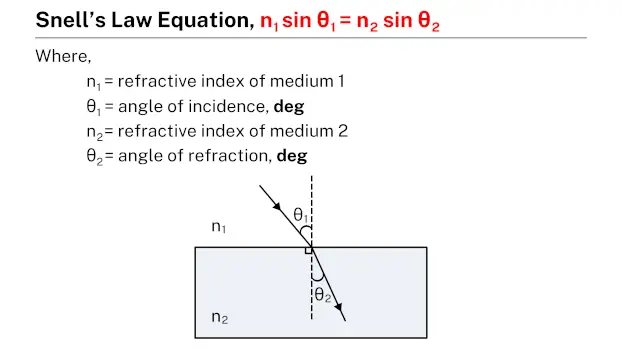
Snell’s law describes the relationship between the angles of incidence and refraction when a light wave passes from one medium into another with a different refractive index. According to Snell’s law, the ratio of the sine of the angle of incidence to the sine of the angle of refraction is constant and is equal to the ratio of the refractive indices of the two media. This law is fundamental in understanding how light bends, or refracts, when it enters a different medium. For example, when light passes from air (with a refractive index of approximately 1) into water (with a refractive index of about 1.33), it bends towards the normal due to the change in speed of light in the two different media.
Snell’s law is mathematically expressed as:
$$n_{1}sin\theta_{1} = n_{2}sin\theta_{2}$$where n1 and n2 are the refractive indices of the first and second media, respectively, and θ1 and θ2 are the angles of incidence and refraction, respectively.
Practice problems
Problem #1
A ray of light moving through medium 1 with a refractive index of 1 enters medium 2 with a refractive index of 1.33. If the angle of incidence is 30°, what is the angle of refraction?
Solution
Given data:
- Refractive index of medium 1, n1 = 1
- Refractive index of medium 2, n2 = 1.33
- Angle of incidence, θ1 = 30°
- Angle of refraction, θ2 = ?
Applying the formula:
- n1 sin θ1 = n2 sin θ2
- 1 × sin (30°) = 1.33 × sin θ2
- 1 × 0.5 = 1.33 × sin θ2
- 0.5 = 1.33 × sin θ2
- sin θ2 = 0.3759
- θ2 = sin-1 (0.3759)
- θ2 = 22.07°
Therefore, the angle of refraction is 22.07°.
Problem #2
A laser beam traveling through medium 1 has an angle of incidence of θ1 = 40° and a refractive index of n1 = 1.33. If the angle of refraction is θ2 = 45°, calculate the refractive index of medium 2.
Solution
Given data:
- Angle of incidence, θ1 = 40°
- Refractive index of medium 1, n1 = 1.33
- Angle of refraction, θ2 = 45°
- Refractive index of medium 2, n2 = ?
Applying the formula:
- n1 sin θ1 = n2 sin θ2
- 1.33 × sin (40°) = n2 × sin (45°)
- 1.33 × 0.6427 = n2 × 0.7071
- n2 = 0.8547 ÷ 0.7071
- n2 = 1.20
Therefore, the refractive index of medium 2 is 1.20.
Problem #3
A ray traveling through medium 1 with a refractive index of n1 = 1.3 enters medium 2 with a refractive index of n2 = 1.4. Calculate the angle of incidence if the angle of refraction is 25°.
Solution
Given data:
- Refractive index of medium 1, n1 = 1.3
- Refractive index of medium 2, n2 = 1.4
- Angle of incidence, θ1 = ?
- Angle of refraction, θ2 = 25°
Applying the formula:
- n1 sin θ1 = n2 sin θ2
- 1.3 × sin θ1 = 1.4 × sin (25°)
- 1.3 × sin θ1 = 1.4 × 0.4226
- 1.3 × sin θ1 = 0.5916
- sin θ1 = 0.5961 ÷ 1.3
- sin θ1 = 0.4585
- θ1 = sin-1 (0.4585)
- θ1 = 27.29°
Therefore, the angle of incidence is 27.29°.
Problem #4
A light traveling through medium 1 with an unknown refractive index enters medium 2 with a refractive index of n2 = 1.2. If the angle of incidence is 20° and the angle of refraction is 35°, what is the refractive index of medium 1?
Solution
Given data:
- Refractive index of medium 2, n2 = 1.2
- Angle of incidence, θ1 = 20°
- Angle of refraction, θ2 = 35°
- Refractive index of medium 1, n1 = ?
Applying the formula:
- n1 sin θ1 = n2 sin θ2
- n1 × sin (20°) = 1.2 × sin (35°)
- n1 × 0.3420 = 1.2 × 0.5735
- n1 × 0.3420 = 0.6882
- n1 = 0.6882 ÷ 0.3420
- n1 = 2.01
Therefore, the refractive index of medium 1 is 2.01.
More topics
- Law of conservation of energy
- Newton’s law of universal gravitation
- Newton’s law of cooling
- Coulomb’s law
- Snell’s law
- Ohm’s law
- Hooke’s law
External links
- https://www.britannica.com/science/Snells-law
- https://www.physicsclassroom.com/class/refrn/Lesson-2/Snell-s-Law
- https://www.omnicalculator.com/physics/snells-law
- https://study.com/learn/lesson/what-is-snells-law-equation-examples.html
- https://www.studysmarter.us/explanations/physics/waves-physics/snells-law/
Deep
Learnool.com was founded by Deep Rana, who is a mechanical engineer by profession and a blogger by passion. He has a good conceptual knowledge on different educational topics and he provides the same on this website. He loves to learn something new everyday and believes that the best utilization of free time is developing a new skill.
